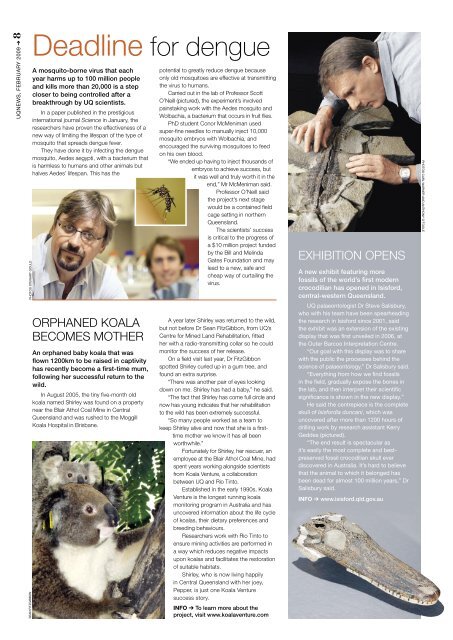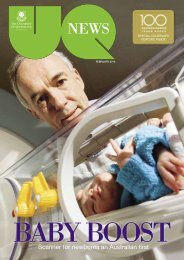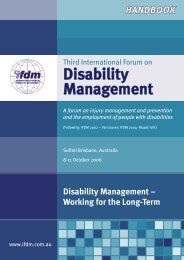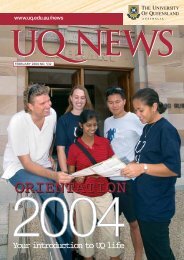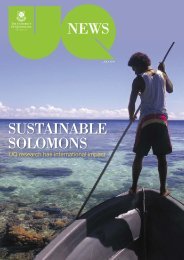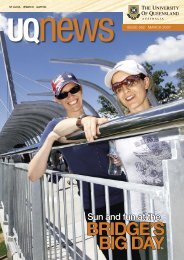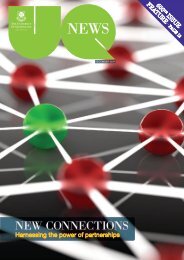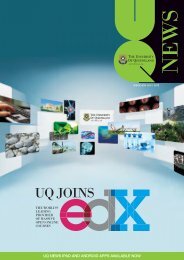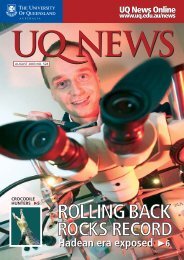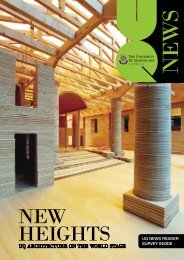Margaret Olley: Life's journey - Office of Marketing and ...
Margaret Olley: Life's journey - Office of Marketing and ...
Margaret Olley: Life's journey - Office of Marketing and ...
- No tags were found...
Create successful ePaper yourself
Turn your PDF publications into a flip-book with our unique Google optimized e-Paper software.
UQNEWS, FEBRUARY 2009 ➔ 8SEAN FITZGIBBON PHOTOS STEWART GOULDDeadline for dengueA mosquito-borne virus that eachyear harms up to 100 million people<strong>and</strong> kills more than 20,000 is a stepcloser to being controlled after abreakthrough by UQ scientists.In a paper published in the prestigiousinternational journal Science in January, theresearchers have proven the effectiveness <strong>of</strong> anew way <strong>of</strong> limiting the lifespan <strong>of</strong> the type <strong>of</strong>mosquito that spreads dengue fever.They have done it by infecting the denguemosquito, Aedes aegypti, with a bacterium thatis harmless to humans <strong>and</strong> other animals buthalves Aedes’ lifespan. This has theORPHANED KOALABECOMES MOTHERAn orphaned baby koala that wasflown 1200km to be raised in captivityhas recently become a first-time mum,following her successful return to thewild.In August 2005, the tiny five-month oldkoala named Shirley was found on a propertynear the Blair Athol Coal Mine in CentralQueensl<strong>and</strong> <strong>and</strong> was rushed to the MoggillKoala Hospital in Brisbane.potential to greatly reduce dengue becauseonly old mosquitoes are effective at transmittingthe virus to humans.Carried out in the lab <strong>of</strong> Pr<strong>of</strong>essor ScottO’Neill (pictured), the experiment’s involvedpainstaking work with the Aedes mosquito <strong>and</strong>Wolbachia, a bacterium that occurs in fruit flies.PhD student Conor McMeniman usedsuper-fine needles to manually inject 10,000mosquito embryos with Wolbachia, <strong>and</strong>encouraged the surviving mosquitoes to feedon his own blood.“We ended up having to inject thous<strong>and</strong>s <strong>of</strong>embryos to achieve success, butit was well <strong>and</strong> truly worth it in theend,” Mr McMeniman said.Pr<strong>of</strong>essor O’Neill saidthe project’s next stagewould be a contained fieldcage setting in northernQueensl<strong>and</strong>.The scientists’ successis critical to the progress <strong>of</strong>a $10 million project fundedby the Bill <strong>and</strong> MelindaGates Foundation <strong>and</strong> maylead to a new, safe <strong>and</strong>cheap way <strong>of</strong> curtailing thevirus.A year later Shirley was returned to the wild,but not before Dr Sean FitzGibbon, from UQ’sCentre for Mined L<strong>and</strong> Rehabilitation, fittedher with a radio-transmitting collar so he couldmonitor the success <strong>of</strong> her release.On a field visit last year, Dr FitzGibbonspotted Shirley curled up in a gum tree, <strong>and</strong>found an extra surprise.“There was another pair <strong>of</strong> eyes lookingdown on me. Shirley has had a baby,” he said.“The fact that Shirley has come full circle <strong>and</strong>now has young indicates that her rehabilitationto the wild has been extremely successful.“So many people worked as a team tokeep Shirley alive <strong>and</strong> now that she is a firsttimemother we know it has all beenworthwhile.”Fortunately for Shirley, her rescuer, anemployee at the Blair Athol Coal Mine, hadspent years working alongside scientistsfrom Koala Venture, a collaborationbetween UQ <strong>and</strong> Rio Tinto.Established in the early 1990s, KoalaVenture is the longest running koalamonitoring program in Australia <strong>and</strong> hasuncovered information about the life cycle<strong>of</strong> koalas, their dietary preferences <strong>and</strong>breeding behaviours.Researchers work with Rio Tinto toensure mining activities are performed ina way which reduces negative impactsupon koalas <strong>and</strong> facilitates the restoration<strong>of</strong> suitable habitats.Shirley, who is now living happilyin Central Queensl<strong>and</strong> with her joey,Pepper, is just one Koala Venturesuccess story.INFO ➔ To learn more about theproject, visit www.koalaventure.comEXHIBITION OPENSA new exhibit featuring morefossils <strong>of</strong> the world’s first moderncrocodilian has opened in Isisford,central-western Queensl<strong>and</strong>.UQ palaeontologist Dr Steve Salisbury,who with his team have been spearheadingthe research in Isisford since 2001, saidthe exhibit was an extension <strong>of</strong> the existingdisplay that was first unveiled in 2006, atthe Outer Barcoo Interpretation Centre.“Our goal with this display was to sharewith the public the processes behind thescience <strong>of</strong> palaeontology,” Dr Salisbury said.“Everything from how we find fossilsin the field, gradually expose the bones inthe lab, <strong>and</strong> then interpret their scientificsignificance is shown in the new display.”He said the centrepiece is the completeskull <strong>of</strong> Isisfordia duncani, which wasuncovered after more than 1200 hours <strong>of</strong>drilling work by research assistant KerryGeddes (pictured).“The end result is spectacular asit’s easily the most complete <strong>and</strong> bestpreservedfossil crocodilian skull everdiscovered in Australia. It’s hard to believethat the animal to which it belonged hasbeen dead for almost 100 million years,” DrSalisbury said.INFO ➔ www.isisford.qld.gov.auPHOTOS CARL WARNER AND ANTHONY O’TOOLE


